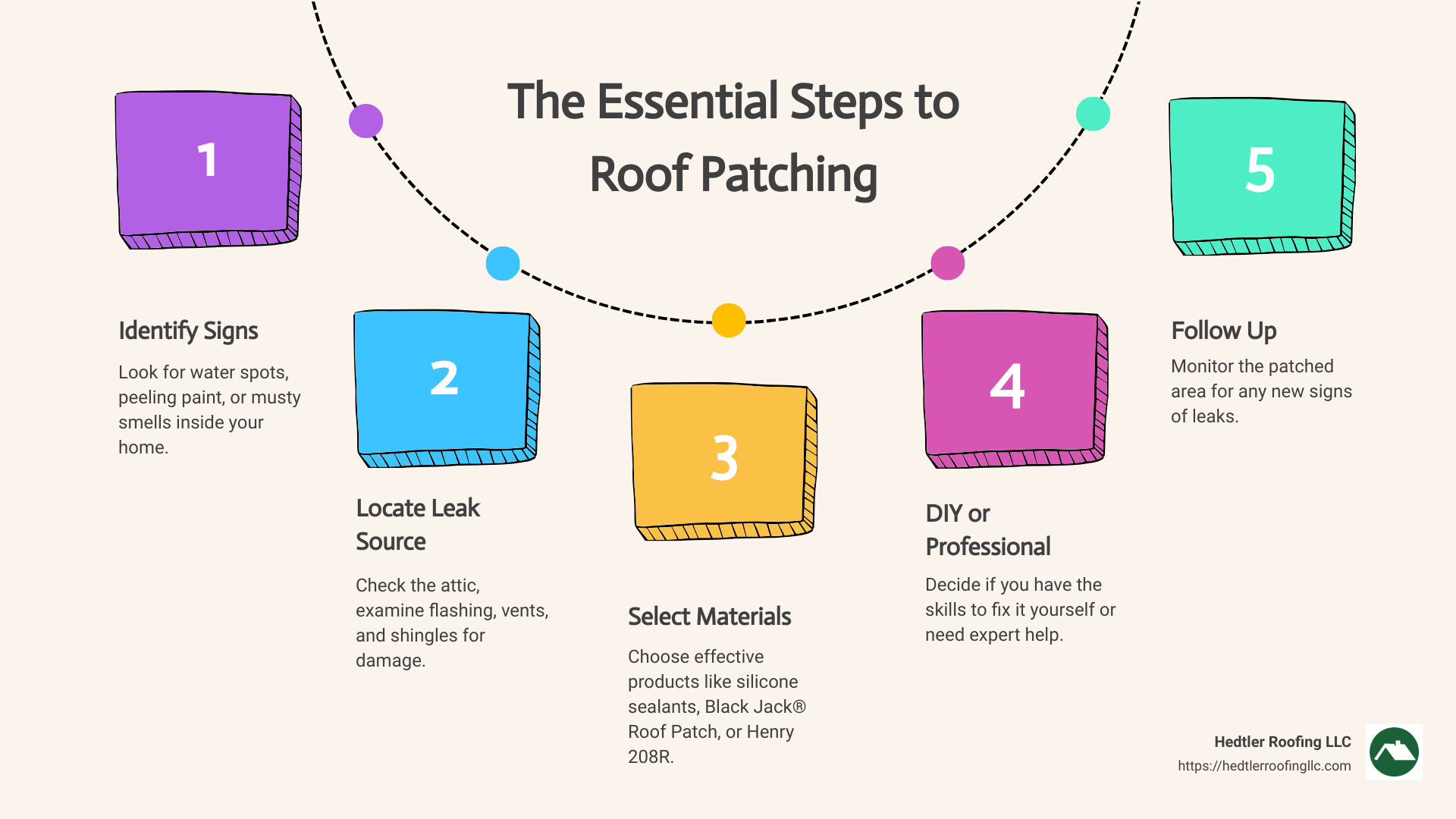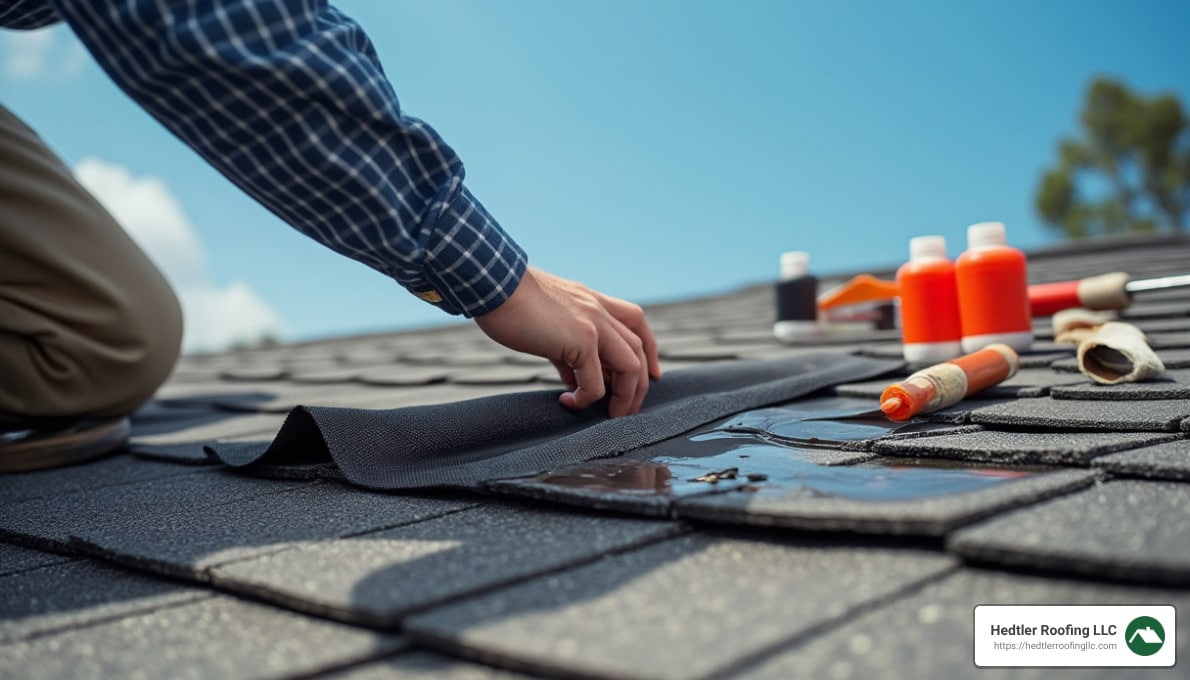Roof Patching: Top Products & Tips for 2025 Success
Roof patching is essential for Massachusetts homeowners who want to avoid costly repairs and maintain their home’s integrity. Whether you’re dealing with pesky leaks, seeking effective roof repair options, or finding reliable products to patch your roof, it’s crucial to act quickly to prevent further damage.
To grasp the essentials of roof patching, here are a few quick pointers:
– Identify signs of a leak: water spots, musty smells, or peeling paint.
– Locate the source: inspect the attic, check flashing, vents, and shingles.
– Choose the right patching products: silicone roof sealants, Black Jack® Roof Patch, or Henry 208R.
– Decide whether to DIY or call a professional roofer.
I’m Jason Hedtler, owner of Roof Experts, with years of experience in roof patching in the Massachusetts region. I’ve helped countless homeowners keep their roofs in top shape. Let’s explore strategies and tips to tackle roof patching effectively.

Learn more about roof patching:
– best roof sealant for leaks
– roof flashing repair
– how to fix a leaking flat roof
How to Identify a Roof Leak
Common Signs of Roof Leaks
Spotting a roof leak early can save you a lot of hassle. Here’s how to identify the telltale signs:
1. Wet Spots and Water Stains:
Keep an eye out for wet spots on your ceilings or walls. These often appear as discolored patches or rings, indicating water seepage. If you notice them, it’s time to investigate further.
2. Musty Smells and Mold:
A musty smell in any room could mean moisture is present. Mold often grows in damp areas, so if you spot it, there’s likely a leak nearby. Mold can be a health hazard, so take action quickly.
3. Peeling Paint and Damaged Insulation:
Peeling paint around windows and doors can signal water intrusion. Similarly, check your attic for damp insulation, which could point to a roof leak.
4. Rotting Wood and Structural Damage:
Rotting wood, especially in your attic or roof sheathing, is a serious sign of prolonged water exposure. This can compromise your home’s structural integrity.
5. Flashing, Vent Pipes, and Dormers:
Inspect the flashing around roof features like chimneys and dormers. Cracks or gaps here can allow water to enter. Pay attention to vent pipes and roof-pitch transition points, as they are common leak sources.
6. Exterior Water Stains:
Look for water stains or streaks on your home’s exterior walls, particularly below rooftop vents and gutters. These can indicate that water is entering through an unidentified opening.
By regularly checking these areas, you can catch potential issues before they escalate into major problems. For Massachusetts homeowners, keeping your roof in top shape is crucial, especially given the region’s weather challenges. If you suspect a leak, consider contacting a professional to assess and address the issue promptly.
Best Products for Roof Patching
When it comes to roof patching, having the right products on hand can make all the difference. Whether you’re dealing with a small leak or a significant repair, choosing the right materials can ensure long-lasting results and prevent further damage. Here’s a look at some of the best products available for patching roofs, perfect for Massachusetts homeowners facing the region’s unpredictable weather.
Silicone Roof Sealants
Silicone roof sealants are a popular choice for homeowners due to their exceptional water resistance and UV reflectivity. These sealants provide a flexible, durable barrier that can withstand harsh weather conditions, making them ideal for both small repairs and larger patches. Their long-lasting nature ensures that once applied, you won’t have to worry about frequent reapplications. Plus, they adhere well to most roofing materials, offering a seamless finish.
Black Jack® Roof Patch
For those looking for a flexible repair compound, the Black Jack® Roof Patch is a standout option. This product is designed to patch splits, cracks, and holes up to 1 inch wide, offering a quick-drying solution with excellent adhesion. When used with reinforcing fabric, it remains flexible, expanding and contracting with temperature changes. It’s particularly effective for use with reflective roof products, making it a versatile choice for various roofing needs.

Henry 208R Rubberized Wet Patch
The Henry 208R Rubberized Wet Patch is another excellent product, especially for those looking for a waterproof patch. Its rubber-modified formula provides a strong seal that can handle a wide temperature range, ensuring durability even in fluctuating weather conditions. This product is perfect for emergency repairs, as it can be applied to wet surfaces, allowing you to address leaks promptly without waiting for dry conditions.
For Massachusetts homeowners, these products offer reliable solutions to common roofing issues. Whether you’re tackling a minor leak or preparing for the next big storm, having these tools in your arsenal can help maintain your roof’s integrity and protect your home from water damage.
In the next section, we’ll walk you through a step-by-step guide to applying these products effectively, ensuring your roof patching efforts are successful and long-lasting.
Step-by-Step Guide to Roof Patching
Tackling a roof patching project might seem daunting, but with the right tools and a clear plan, you can handle minor repairs yourself. Let’s break it down into simple steps.
Materials Needed
Before you start, gather all necessary materials:
- Flat bar: Essential for removing old shingles and nails.
- Utility knife: Handy for cutting shingles.
- Caulk gun: Used to apply sealant smoothly.
- Roof sealant: Seals edges and prevents leaks.
- Hammer: For driving nails.
- Roofing nails: Secure new shingles in place.
- New shingles: To replace damaged ones.
Patching Asphalt Shingles
- Locate the Leak: Begin by identifying the source of the leak. Look for water stains or damp spots on the ceiling and trace them back to the roof.
- Inspect Damage: Once you find the leak, inspect the area for damaged shingles. Look for cracks, missing pieces, or curled edges.
- Remove Old Shingle: Use the flat bar to carefully lift the damaged shingle. Slide the bar under the shingle to loosen the nails, then remove them. Be gentle to avoid damaging surrounding shingles.
- Slide in New Shingle: Position the new shingle in place. Ensure it aligns with the existing shingles for a seamless look.
- Nail in Place: Secure the new shingle with roofing nails. Aim for just above the adhesive line to ensure a strong hold.
- Apply Sealant: Use the caulk gun to apply a bead of sealant along the edges of the new shingle. This prevents water from seeping underneath.
Fixing Leaks in Vent Boots
- Inspect the Boot: Check the rubber boot around vent pipes for cracks or tears. Damaged boots can lead to leaks.
- Replace Boot: Slide the old boot off the pipe. Fit a new boot over the pipe, ensuring it sits snugly.
- Apply Sealant: Apply a generous amount of roof sealant around the base of the new boot to ensure a watertight seal.
- Secure Flashing: Reattach any flashing around the vent. Use roofing nails to secure it, then cover the nail heads with sealant to prevent leaks.
- Check for Additional Leaks: Once repairs are complete, inspect the surrounding area for any other potential leaks. A thorough check can save you from future issues.
By following these steps, you’ll be well on your way to a successful roof patching. Safety is crucial, so always take precautions when working at heights. In the next section, we’ll explore temporary solutions for roof leaks, providing quick fixes for urgent situations.
Temporary Solutions for Roof Leaks
When you spot a leak in your roof, it’s crucial to act quickly to prevent further damage. While a permanent fix might require professional help, there are temporary solutions you can apply to keep your home dry until then.
Using Tar Paper
Tar paper is a reliable material for quick, temporary fixes. It’s strong, flexible, and weather-resistant.
- Measure the Area: Start by measuring the damaged section of your roof. Cut enough tar paper to cover this area with some overlap.
- Staple the Tar Paper: Once cut, staple the tar paper directly onto the roof. Use galvanized staples or nails to ensure they don’t rust over time.
- Apply Adhesive: To secure the tar paper further, use a quality roofing adhesive around the edges. This creates a strong bond and helps prevent water from seeping underneath.
- Seal with Roof Sealant: Finish by applying a layer of roof sealant over the tar paper. This adds an extra layer of protection and ensures the patch is waterproof.
Using Plastic Sheeting
Plastic sheeting is another effective temporary solution, especially in emergencies.
- Cover the Leak: Spread the plastic sheeting over the leak, ensuring it extends well beyond the damaged area.
- Secure with Weights: To hold the plastic in place, use weights like bricks or stones. This prevents the wind from lifting the plastic.
- Fasten with Roofing Nails: For added security, use roofing nails along the edges of the plastic. Make sure they are placed in areas that won’t allow water to seep in.
- Use Duct Tape: Seal the edges with duct tape for extra protection. This helps keep the plastic in place and adds another barrier against water.
Both tar paper and plastic sheeting are excellent for temporary roof patching. They provide quick fixes until you can address the issue permanently. These are not long-term solutions, so schedule a professional inspection as soon as possible to ensure your roof remains in good condition.
Frequently Asked Questions about Roof Patching
What is the best for patching the roof?
When it comes to roof patching, the choice of product can make a significant difference. Silicone roof sealants are often considered the best due to their water resistance and UV reflectivity. These sealants form a durable and flexible layer that prevents water from seeping in and reflects harmful UV rays, which can degrade roofing materials over time. This makes them a long-lasting solution for sealing leaks and preventing further damage.
Other effective products include Black Jack® Roof Patch, known for its flexibility and quick-drying properties, and Henry 208R Rubberized Wet Patch, which boasts a rubber-modified formula for waterproofing in a wide temperature range.
Can you patch a roof yourself?
Yes, you can patch a roof yourself, especially if you’re dealing with minor issues. Small leaks or damaged shingles can often be fixed with a bit of DIY know-how. However, it’s crucial to assess your skill level before attempting any repairs. Working on a roof can be risky, and improper repairs can lead to more significant problems down the line.
Potential risks include personal injury from falls and the possibility of worsening the damage if the patch is not applied correctly. If you’re unsure, it’s always best to consult a professional to ensure the job is done safely and effectively.
How long does patching a roof last?
The longevity of a roof patch largely depends on the extent of the damage and the quality of the materials used. Minor patches using high-quality products like silicone sealants can last several years, especially if applied correctly. However, if the damage is extensive, a patch may only be a temporary fix until a more comprehensive repair or replacement can be scheduled.
Regular inspections and maintenance are key to ensuring that patches last as long as possible. Catching issues early and addressing them promptly can prevent the need for an extensive overhaul and extend the life of your roof.
Conclusion
When it comes to maintaining the integrity of your home, roof patching is a critical aspect that should not be overlooked. Massachusetts homeowners understand the importance of protecting their investment from the unpredictable New England weather. That’s where Roof Experts steps in. With over 20 years of experience, we are committed to providing high-quality workmanship and exceptional customer service in the Franklin and Wareham areas.
Our team specializes in detailed roof inspections, ensuring that any signs of leaks or damage are identified early. This proactive approach not only prevents minor issues from escalating but also extends the life of your roof. We know that every homeowner’s needs are unique, and our custom solutions reflect this understanding.
Choosing the right roofing contractor is crucial, and we pride ourselves on being a reliable choice for homeowners across Massachusetts. Our expertise in roof installations, replacements, and repairs ensures that your home is in capable hands. Whether it’s a minor patch or a major repair, we use only the best materials and techniques to guarantee lasting results.
If you’re experiencing roof issues or simply want peace of mind, don’t hesitate to schedule a professional roof inspection with us. At Roof Experts, we are dedicated to delivering value and ensuring your home’s safety and longevity.
For more information on our services, visit our Roof Repairs page. Let us help you keep your home safe and sound.


